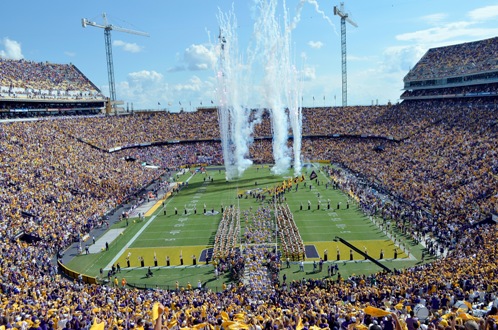Hotty toddy! War Eagle! Roll Tide!
All of these chants are synonymous with college football in the Southeastern Conference (SEC), which received landmark television coverage this fall through a new ESPN agreement.
The SEC Network launched August 14 to a projected 75 million subscribers and provides unparalleled access to an already powerful conference. In total, the channel will air 45 football games, 100 men’s basketball games, 60 women’s basketball games and others from the SEC’s 21 annual sports, totaling more than 1,000 live events.
Does the additional coverage create added pressure for members of the Sports Turf Managers Association (STMA) at SEC schools?
One person who knows exactly what this stress surmounts to is Eric Fasbender, CSFM, Assistant Director for Facilities and Grounds at Louisiana State University (LSU) and STMA member since 2001.
Fasbender and his team are responsible for preparing Tiger Stadium and its 120 yards of Celebration bermudagrass, which is no small feat. Before each home game, the field’s end zone, logos and yard line markings are re-painted, along with the “Tiger Eye” at midfield. The LSU turf crew carefully paints the field twice to ensure the colors pop on game day.
The Tiger Eye is crafted with the skill and care of a master artist. It is a complex project accomplished by layering white, purple and gold. Including drying time, the task takes more than 2 hours. Fasbender paints the Tiger Eye every week, noting “it is the only part of the field that we do not use a stencil.”
While painting the field tends to garner the most commentary from Tiger fans, Fasbender and his crew are more concerned about the field’s playability and safety of the players, coaches and referees. When rain is in the forecast, the field is aerated for ease of drainage and a thin layer of sand is applied to aid in traction for the players. Fasbender even walks the field in his socks Friday afternoons before home games to feel how the natural grass will perform.
For collegiate level turf grass managers, game days are the first priority but college football stadiums have evolved into multi-use facilities. For example, Auburn University hosts several events on the natural grass field at Jordan Hare Stadium. It has been the site for concerts, graduation ceremonies, autograph sessions, movie nights, television commercials and, most recently, Café Jordan Hare.
Café Jordan Hare is a unique fan experience to Auburn. The university creates a VIP gourmet dinner on the field on select Fridays before home games. Setup includes tables, chairs, leather couches, serving lines, bars, grilles and even a jazz band. Eric Kleypas, the Director of Turf and Landscaping for Auburn University Athletics, noted the most challenging part was “ensuring they were able to move all the furniture and food on and off the field without damaging the natural grass.”
Eric’s turf crew goes the extra mile around home games to give the Auburn fans a more intimate experience with the historic field. It adds work hours and pressure to his job but he enjoys the satisfaction die-hard fans receive with the up-close and personal experience.
But it’s not just the SEC that feels the extra pressure of added events and television time. Jeff Salmond, CSFM, Director of Athletic Fields for the University of Oklahoma, has been dealing with the critical eye of television crews for seven years as a member of the Big 12 Conference.
The Big 12 created its own TV network in 2007 with FOX Sports and has approximately 52 million subscribers in North America.
“You’re on display for national audiences, for recruits and for fans that come and walk through the stadium,” says Salmond, STMA’s current Secretary / Treasurer. “The joy is at the end of the game and seeing how the field has performed.”
Salmond and his eight-man staff manage all the University of Oklahoma’s athletic fields. The most visible and important work is inside Gaylord Family Memorial Stadium, where the football team competes on Saturdays. In addition to painting the field before every game, the Sooner turf crew monitors the field’s hardness, measured on a numeric scale called Gmax.
Gmax is calculated by dropping a weight onto the field and noting how fast it stops after hitting. A higher Gmax equals a quicker stopping rate, which equals a harder surface. The National Football League requires all fields to be below 100 Gmax but the NCAA does not have similar requirements.
Salmond holds his staff to the NFL’s standard. In addition to producing a visually-appealing field for millions of TV viewers and game day attendees, Salmond takes pride in the safety and condition for participating players.
In the era of high-definition TVs and endless media coverage, sports turf managers face increasing scrutiny. The goal of providing the safest and best conditioned field possible remains the same. Fasbender, Kleypas and Salmond are just a few of the superior turf managers working on college campuses across the country.
By Mara Rice and Glenn Gray, Buffalo Brand Invigoration Group


